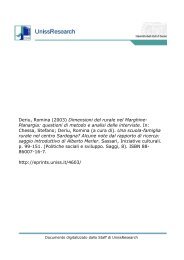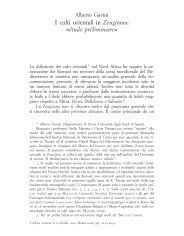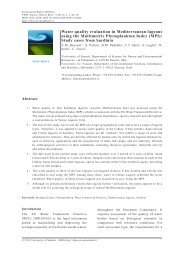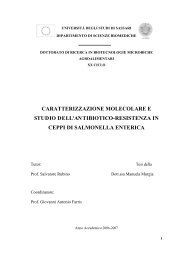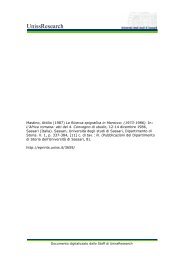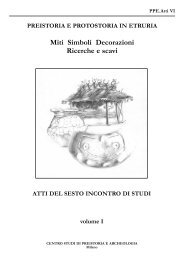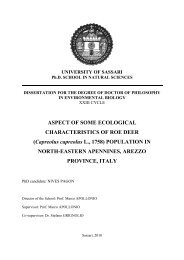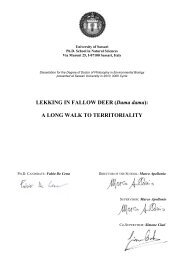L'Africa romana - UnissResearch - Università degli Studi di Sassari
L'Africa romana - UnissResearch - Università degli Studi di Sassari
L'Africa romana - UnissResearch - Università degli Studi di Sassari
You also want an ePaper? Increase the reach of your titles
YUMPU automatically turns print PDFs into web optimized ePapers that Google loves.
504 Michael Speidel<br />
15 [V]al(erius) Ma[ ... ]atius, dec(urio)<br />
[al]ae III Asturum prae-<br />
[po]situs castelli Tamu-<br />
[den]sis cl!(l!um produx-<br />
[it] III Idus Apri/es<br />
20 [Fa]ustino et Rufino<br />
[co (n)]s(ulibus), et deinceps ob<br />
[ser]vabimus.<br />
(April Il)<br />
(a. 210)<br />
In line 18 the e<strong>di</strong>tor read c[ul]tum or c[iv]ium 3 • C[ul]tum, however,<br />
cannot be right, for the letter after C, showing a straight shaft, is clearly<br />
not a V. The rea<strong>di</strong>ng c[iv]ium, on the other hand, might fit the preserved<br />
traces of letters but makes no sense. As the e<strong>di</strong>tor rightly saw, the<br />
final phrase «and henceforeward we shall honor» is said by the sol<strong>di</strong>ers<br />
and therefore the word in the middle of line 18 should refer to a religious<br />
object 4 •<br />
It seems one should re ad cl!(l!um. Admittedly the second, third, and<br />
fourth letters are doubtful, but they agree with the traces preserved 5 • Cereus<br />
is a wax candle, Iit in processions and before statues 6 • The army<br />
used cerei in its religious ceremonies to such an extent that there existed<br />
a special rank for it, the immunis caere[7. As the day of the de<strong>di</strong>cation,<br />
Aprilll, was Septimius Severus' birthday, no doubt the emperor's statue<br />
was honored with a candle-Iight ceremony. The findspot of the slab<br />
is not known, but if otir rea<strong>di</strong>ng is correct, in would come from the headquarters<br />
buil<strong>di</strong>ng of the unit stationed at Tamuda 8 •<br />
3 See now the oral communication of M. EUZENNAT, Xe Congrès Internationa/ d'Épigraphie<br />
Grecque et Latine, Nimes 1992: c{lipeJum [n.d.e.].<br />
4 Ge{nJium produxit «he honored the Genius» would make sense, but the incurling<br />
or downslanting stroke that sets the G off from a C is missing. For the meaning of producere<br />
«to promote in rank or status» see the OxJord Latin Dictionary s.v. S. 1473. 8.<br />
Observare is often used together with co/ere and thus has the same meaning, see OLD<br />
S.v. 1222, 8.<br />
5 On the published photograph (MASTINO 1990, fig. 5) the topmost part of the R is<br />
stili visible. To be sure, the second E seems to lack a horizontal stroke in the middle, but<br />
this is true also of the E in castelli or in dec(urio).<br />
6 ThLL s.v. cereus; C/L VIII 9052,13: ut statuam mean .. , coronet et cer(eos) II accendat;<br />
Ammianus Marcellinus 22, 13.<br />
7 eIL III, 14358.2 (Carnuntum). See H.G. PFLAUM, AJrique Romaine. Scripta Varia<br />
I, 1978, p. 7. See DEssAu, lLS 8940: Dei sancti Solis simu/acrum consecr(atum) <strong>di</strong>e<br />
XliII ka/(endas) Decen(bres) debet singu/is annis iusso sacro dd.nn. Licini Aug(usti) et Licini<br />
Caes(aris) ture cereis et proJusionibus eodem ide a praep(ositis) et vexillat(ione) in cast(ris)<br />
Salsoviensib(us) agentib(us) exorari.<br />
8 Very likely a detachment of Brittones, see, Inscriptions Antiques du Maroc, II, Inscriptions<br />
/atines, 1982, nr. 56; see MASTINO 1990, p. 266.<br />
The Cereus oJ Tamuda 505<br />
Fig. l: Tamuda (MASTINO, 1990, p. 256 fig. 2).



